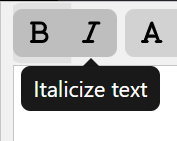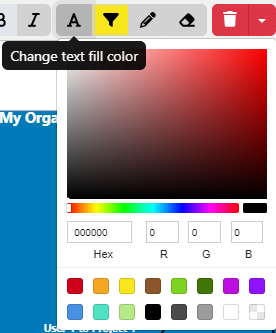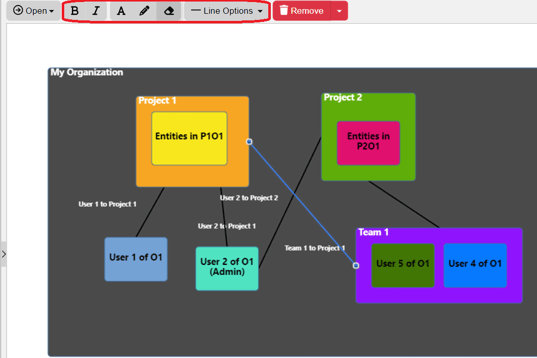Layer Diagram Modifications & Settings
Below we'll cover editing constructs of the Layer Diagram and the Diagram's settings options.
| Asset Construct Editing | A review of the Asset construct editing options |
| Conduit Construct Editing | A review of the Conduit construct editing options |
| Multiple Constructs Editing | A review of the editing options for multiple constructs |
| Layer Diagram Settings | A review of the Layer Diagram's settings. |
The previous article was an introductory article to the Layer Diagram. In this article, we'll go over the editing options and the Layer Diagrams settings options.
Asset Construct Editing

Upon selecting an Asset construct on the Layer Diagram, users have options on the top toolbar frame to modify it on the canvas, below we will cover each option.
Bold

This option will Bold the name of the construct selected on the canvas.
Italicize

This option will Italicize the name of the construct selected on the canvas.
Change Text Fill Color

Using the HTML Color Picker that drops down from the Text Fill Color Option, users can change the text color of the Asset selected on the canvas by selecting the color associated to the desired color simply inputting in the Hex, R, G, B fields the proper codes and numbers.
Change Fill Color

Using the HTML Color Picker that drops down from the Change Fill Color Option, users can change the color of the Asset selected on the canvas.
Change Stroke/line color

Using the HTML Color Picker that drops down from the Change Line/Stroke Color Option, users can change the color that borders the Asset construct selected on the canvas.
Reset Color back to default

The Reset color back to default option will change the construct selected on the canvas back to the default gray and black colors.
Conduit Construct Editing

Upon selecting a Block construct on the BDD, users have options on the top toolbar frame to modify it on the canvas, below we will cover each option.
Bold

This option will Bold the name of the entity selected on the canvas.
Italicize

This option will Italicize the name of the Block selected on the canvas.
Change Text Fill Color

Using the HTML Color Picker that drops down from the Text Fill Color Option, users can change the text color of the Block selected on the canvas by selecting the color associated to the desired color simply inputting in the Hex, R, G, B fields the proper codes and numbers.
Change Fill Color

Using the HTML Color Picker that drops down from the Change Fill Color Option, users can change the color of the Block selected on the canvas.
Change Stroke/line color

Using the HTML Color Picker that drops down from the Change Line/Stroke Color Option, users can change the color that borders the Block selected on the canvas.
Reset Color back to default

The Reset color back to default option will change the entity selected on the canvas back to the default gray and black colors.
Multiple Constructs Editing

To select multiple Assets on the canvas, users can simply drag their cursor outside of the constructs and a box will appear. This allows users to choose as multiple Layer 1 Assets as they desire. Once selected, editing options will appear on the top toolbar for users to utilize. Let's explore each option as highlighted above.
Bold

This option will Bold all the names of the Layer 1 Asset constructs.
Italicize

This option will Italicize all the names of the Layer 1 Asset constructs.
Change Text Fill Color

Using the HTML Color Picker that drops down from the Text Fill Color Option, users can change the text color of the Layer 1 Asset constructs selected on the canvas by selecting the color associated close to the desired color simply inputting in the Hex, R, G, B fields the proper codes and numbers.
Change Fill Color

Using the HTML Color Picker that drops down from the Text Fill Color Option, users can change the color of the Layer 1 Asset constructs selected on the canvas.
Change Stroke/line color

Using the HTML Color Picker that drops down from the Change Stroke/Line Color Option, users can change the colors of the Layer 1 Asset constructs selected on the canvas.
Reset Color back to default

The Reset color back to default option will change the Layer 1 Asset constructs selected on the canvas back to the default black and gray colors.
Align Vertically

This selection will align the constructs vertically for the multiple constructs selected on the canvas. The vertical line will start with the highlighted green State, as shown below.

Align Horizontally

This selection will align the constructs horizontally for the multiple Classes selected on the canvas. The horizontal line will start with the highlighted green Class construct, as shown below.

Clone Shape

The Clone Shape option is to bring size uniformity to the diagram's constructs. When this option is selected, the green highlighed entity will be what the other constructs clone to so they are all the same size.
Layer Diagram Settings

The above Layer Diagram Settings menu is the wrench icon on the top right of the toolbar frame. This button is a fixed dropdown and does not change dependent on what the user has selected. Let's delve into the options available in this dropdown below.
Number of Levels

Upon expanding the Number of Levels dropdown in the menu, users have the ability to set their diagrams to show up to 10 levels of decomposition. The level indicated here is what will be indicated in the blue box next to the wrench icon on the top toolbar frame for convenience.
Show/Hide Cross- Project Indicators
![]()
Users may show (or hide, if shown) the indicators on the constructs brought into the model from another Innoslate project.
Auto Number
![]()
Users may Auto Number the constructs with the modal that pops up when this option is selected. Users may auto number the lowest child level displayed and/or add a Prefix.

Layout, Reset Diagram & Help
Lastly, the final options provide users to reset their diagram after changes have been made and layout the diagram after changes are made.
The very last option, 'Help,' will send users directly to the Help Center page for the Layer Diagram for convenience.
To continue learning about General Diagrams, Click Here.
(Next Article: IDEF0 Diagram)

